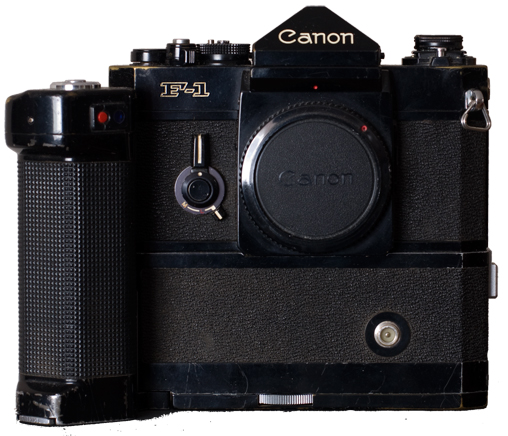
Lens Mount: FD bayonet/breech
Battery: one 1.35v mercury button – EPX 625
Approx. dates of manufacture: 1970 - 1973 (original), 1974-1981 (as F-1n)
Approx. original price: $289.50 (1972)
Approx. street value: Moderately high
This is an original F-1 made by Canon. In 1959, their arch-rival Nikon introduced the Nikon F, which really rocked the photo world. It wasn't the first SLR, it wasn't the first system camera, but it combined high quality accessories with a light, rugged camera at an attractive price. The quailty and price and small size made it very attractive to professionals who could invest in a lot of accessories and mix and match. The camera broke the back of the big press-camera trade; journalists could get outstanding results without having to lug around big Speed Graphics or smaller but unaccessorized Rolleiflexes. And it established the Japanese as makers of quality equipment instead of cheap junk; and they could do it at prices that didn't require a second mortgage on the house (unlike buying Leica equipment).
Nikon had the professional level, 35mm SLR market mostly to itself for ten years as Canon built their foundation for an attack. In the late 60s, Canon came out with its own "F" series cameras (the FX, TL, FT and later the EF): a line of quality 35mm cameras with interchangable lenses and flashes. It took some tweaking to get it right, but by the Nikon F's tenth anniversary, Canon was ready. They introduced their F-1, the flagship of their F-series. The F-1 was truly a system camera: it took all of Canon's high quality optics and the various flash units. But it also accepted motor drives (which automatically wound the film after tripping the shutter. We take this for granted today but at the time they were very heavy, very big and very expensive. Most photographers only used them because they needed the film winding speed for fast action), viewfinder screens, prisms, and all sorts of other goodies. Plus it was pretty much all mechanical—the little button battery only ran the meter. If the battery failed, the camera kept going (albiet without a meter). Try that with modern cameras. If the battery dies, no more camera.
.jpg) It was also rugged as hell. They were nearly all metal, and they were built to pull thousands of rolls of film between failures because pros needed
that reliability. If a camera dies in the studio it's a nuisance, but a dead camera in the field can be a disaster.
It was also rugged as hell. They were nearly all metal, and they were built to pull thousands of rolls of film between failures because pros needed
that reliability. If a camera dies in the studio it's a nuisance, but a dead camera in the field can be a disaster.
The F-1 took off and carved out a place for itself in the professional ranks. It never knocked off Nikon's equivalent F series cameras, but it established Canon as a first-rate competitor to Nikon, and reinforced the Japanese reputation for making oustanding cameras and optics.
The first F-1 came out in 1970 and ran through 1973, and it's typically called the "original" or "mechanical" F-1 by collectors. I picked up this one from eBay in 2004. It was pretty beat up and brassy, but it still cranks along, doing what it was designed to do. That F-1 was on my short "must-have" list of cameras that I've always wanted (like many collectors, I want everything; but there are certain things I really want, as opposed to things that would simply be nice to have).
Because Canon is Canon, and they like to confuse the hell out of people with their branding, they revised the F-1 a bit in 1974 and called it the F-1n (note the lower-case n). It was just a revision: there were only small changes it didn't necessarily rate a new designation. But in 1982 they came out with a new and updated camera; it really was a totally different camera, but they called it The New F-1; collectors typically call it the F-1N (note the upper case N). And of course the accessories are mostly incompatible, so you have to be careful that what you're buying was meant for your own F-1. They did, however, both take the standard Canon FD mount lenses.
For more information: Canon Camera Museum
Modern Photography magazine camera test: May 1971
One of Modern Photography magazine's Top Cameras
Camera manual: Orphan Cameras.com



